Seagate Barracuda 7200.10 750GB: Size Does Matter
by Gary Key on May 18, 2006 9:00 AM EST- Posted in
- Storage
IPEAK File Transfer Tests
Our IPEAK based File Transfer benchmarks indicate how well a drive performs in a strictly read or write operation with a limited number of files (29) but a large amount of data (7.55GB). The test is designed to ensure continual write or read operations across a large section of the drive that requires constant track to track seek requests, actuator movements, and caching large amounts of data.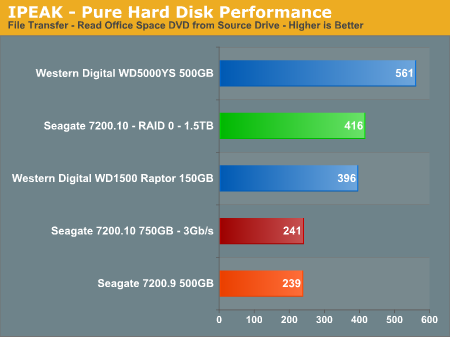
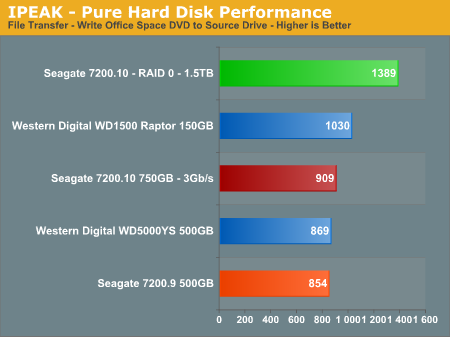
The write performance, and to some degree the read performance, of the 7200.10 RAID 0 combination is impressive in these benchmarks. While we are measuring the actual performance of the hard drive, this is one instance where the RAID 0 setup would show benefits in applications by reducing the time to transfer files.
The Seagate 7200.10 and 7200.9 read performance is dismal compared to the other drives while their write performance is very good. This is very interesting as their read performance in the antivirus test was very good. After further examination of the trace files we noticed the read requests in the antivirus test consisted of mostly small block sizes in irregular patterns compared to very large block sizes in a continual pattern in the file transfer test. It appears in our first couple of benchmarks that the read performance of the 7200.10 drive will be something of interest to look for in the balance of our tests.
Only the RAID 0 result saves the 7200.10 from a very embarrassing performance in this read benchmark and even then it fails to exceed the WD RE2 500GB drive. Speaking of the WD drive, we ran our test repeatedly, created a new trace file, changed drives, and then broke out the stop watch to verify the performance of this drive in our read test. The performance of this drive was fantastic in the read section and quietly fell in behind the Raptor and 7200.10 in the write performance benchmark.
IPEAK Video/Audio Tests
The IPEAK based Video/Audio benchmarks are designed around media encoding and simulating HTPC activities. These are basic benchmarks at this time as this section will be expanded greatly with some new tools that we have developed along with our business partners. Our change to a dual core processor will assist us in maintaining a balance between the CPU and Storage systems during the trace file creation and benchmarking processes. These benchmarks are CPU intensive in nature but also require a balanced storage system with the ability to handle read and write requests simultaneously in a very efficient manner.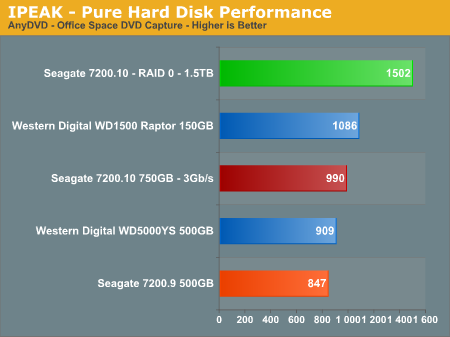
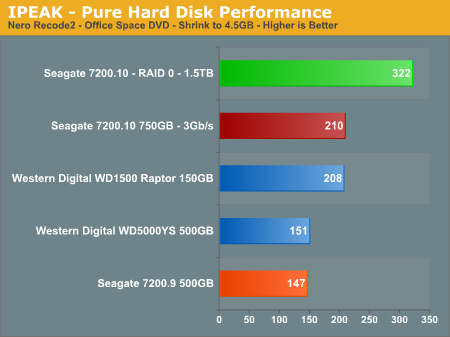
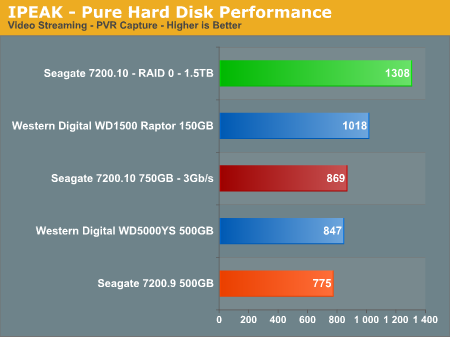
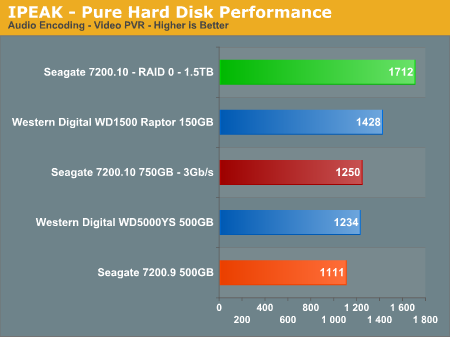
The AnyDVD benchmark is heavily weighted to write requests with the results showing the continued performance advantages of the WD Raptor at the expense of storage capacity, something our Seagate 7200.10 750GB drive has in excess. The performance of the 7200.10 is excellent with a 9% advantage over the WD RE2 and 16% over the 7200.9 drive.
The RAID 0 performance shows the continued strength of this combination in the more intensive I/O benchmarks. Any enthusiasm about the RAID 0 scores should be tempered by the fact that we are measuring hard disk I/O performance and not overall platform performance as several factors within your system can greatly mitigate any advantages we might see in these results. RAID 0 is generally useful in applications where data files are very large and/or data requests are highly sequential in nature, in this case our particular encoding and streaming benchmarks are fit for RAID 0 as it reduces our file transfer times within the actual application.
The NeroRecode 2 benchmark is weighted to streaming read requests but is balanced by continuous write operations. This benchmark is one of the most demanding ones in our test suite with the disk being active the entire trace file with several 100% utilization peaks. The Seagate 7200.10 posts the best scores here with a victory over the Raptor and finishing ahead of the other two 7200 RPM drives by 39%. The inconsistent read results we witnessed earlier were not evident in this benchmark.
Our video and audio encoding benchmarks while streaming a video feed continues to show the strength of the Seagate 7200.10 in the media application benchmarks. While falling behind the Raptor in these two benchmarks, this drive has no trouble finishing ahead of its main competition. The Seagate 7200.10 outperforms the 7200.9 by 12% in both of the media multitasking benchmarks. The drive has very balanced performance and would easily be at home in a HTPC configuration. In fact, this drive should have "PVR Recommended" stamped all over it provided the acoustic levels are acceptable.










44 Comments
View All Comments
segagenesis - Thursday, May 18, 2006 - link
... for when we see 1TB in a single drive. Despite the cost the sheer amount of storage available in a single drive is amazing.One thing I have to question though, maybe I missed it in the article, how much space do you "lose" when you format a 750GB drive? Yes I am aware of the 1000 vs. 1024 bits per byte differences... but how bad is it getting now?
Gary Key - Thursday, May 18, 2006 - link
The capacity differences from the drive manufacturers and what the operating system reports are on page 5. In this case, Seagate claims 750GB, current operating systems will report and provide 698.6GB of storage capacity. :)
mino - Thursday, May 18, 2006 - link
Actually no, there is no "capacity difference".750GB as SI-System Giga-Bytes means 750*10^9 B = 750.000.000.000 bytes = 0.75TB
this will an OS call 750 000 000 000 bytes(B) = 732.421.875 kB = 715.255 MB = 698 GB = 0.682 TB
The amount of data is the same, those are just different units.
Gary Key - Thursday, May 18, 2006 - link
We know this, that is why we do not refer to the drives "formated capacity" as if the drive lost data capacity because you formatted it. He had already mentioned he knew the calculation difference so I was simply answering his question on how the OS would report the data "capacity" (probably the wrong word to use) compared to Seagate in this case. If the drive industry adhered to the standard everyone else is utilizing then life in this case would be simple. ;-)